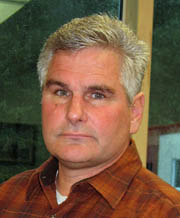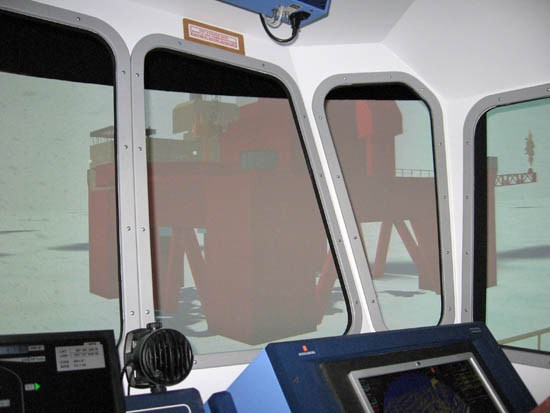
The captain’s sure hand is on the controls..
“Obviously we’ve rigged up this exercise to show you our ice capability, because you might get nautious. The building is not moving, you can probably feel it…”
We are standing on the bridge of a vessel close behind an ice breaking ship ploughing through oil rigs locked into a frozen landscape. We can feel the rolling of the deck, see the golfball size snowflakes pounding on the fo’casle windows —
” I’m going to put the rudder hard over right now, we are picking up speed, we are doing about 8 knots”.. I’m gonna slam the rudder hard left’..” Yeah, because you are going to hit that oil rig in a minute now!’. ” So, as we pick up speed here, come up to 9, see the rudder is actually turning, that’s the rudder angle right there, that clicking you hear is the auto pilot gyro.”
But Wait! It’s all virtual, and it’s all part of a new course that AVTEC is planning to offer come next spring. Scott Hamilton heads AVTEC’s maritime department. He says the course uses ice navigation simulators to replicate the actual experience of operating a ship in Arctic conditions.
“Our theme around here at AVTEC is that the training we like to do is company, area and vessel specific training. You can read the text book, but the real reality is your ability to come in and conduct a vessel, many different types of ships, many different types of cargos. It’s best done safely in a ship’s simulator.”

Hamilton is a former Alaska Marine Highway captain, and he knows what it takes to get mariner’s certifications. He says competition from foreign shipping, especially tourism – related, is skyrocketing in the Arctic
” And we’re not ready. And the Coast Guard understands that, but it is a huge challenge. Most of the traffic that’s operating up there right now is foreign flagged vessels, foreign flagged crews. “
In 2016, new International Marine Organization [IMO] certification standards will kick in for Arctic ship operators. Mike Terminel, is president of AVTEC’s maritime board and a working ship’s captain and ice navigator. He’s got 30 trips to Antarctica under his belt. And he says ice navigation is something that has to be experienced to be learned
“An ice navigator is an individual that has been specially trained to operate in the ice. You can be a captain on a container ship for 25 years and never go into t ice once. That is something the IMO and the US Coast Guard has looked at very carefully these last couple of years and they are going to be implementing rules and endorsements that will be coming out here shortly to make sure that mariners are properly trained when they are in Arctic waters “
Anything north of latitude 60 is considered the Arctic. That means most of Alaska, and the training can be used in all areas – for Cook Inlet oil rigs and Valdez Arm tanker traffic for example. But the far North is a different story. North of the Arctic Circle there are few aids to navigation. Floating and coastal aids are seasonal, charts are not the most accurate and the only real time weather info comes from weather stations at Nome or Red Dog Mine. Navigators there need a specialized background.
Mike Angove, is the simulator engineer at AVTEC. He says the simulators are Norwegian built, at a cost of 2. 5 million dollars.
“They are the top of the line, they are the best in the world, because they got the mathematics correct. It’s what makes our simulators special when compared with other simulators.”
The school has put one million dollars into them since acquiring the simulators, and is looking for further support from the industry. They can be used by individuals, but they can handle groups of 18 at a time for interactive sessions
“We have three full mission bridges that can work interactively in the same exercise. Meaning that, for example, one can be the ship, say an oil tanker and the two others can be tug boats, and we can put hausers or lines between the tug boats and the ship and have an interactive exercise of tug escorg maneuvers and certain maneuvers that are difficult, dangerous and expensive to perform in real life. “

Inside the simulators it’s like a real experience at the helm. Computer programs change the view outside from day to night, or from calm to choppy seas and an operator has to meet maneuvering challenges to avoid obstacles of all kinds. The simulators can mimic conditions at all of the state’s largest ports. Inside, Hamilton brings the simulated ship to the Valdez oil terminal
Hamilton says safety is the main focus of the training. The earliest round of classes will be attended by industry professionals, to offer insights into the course, but after that, AVTEC expects to be able to train about 60 pilots and captains a year. I’m Ellen Lockyer
APTI Reporter-Producer Ellen Lockyer started her radio career in the late 1980s, after a stint at bush Alaska weekly newspapers, the Copper Valley Views and the Cordova Times. When the Exxon Valdez ran aground in Prince William Sound, Valdez Public Radio station KCHU needed a reporter, and Ellen picked up the microphone.
Since then, she has literally traveled the length of the state, from Attu to Eagle and from Barrow to Juneau, covering Alaska stories on the ground for the AK show, Alaska News Nightly, the Alaska Morning News and for Anchorage public radio station, KSKA
elockyer (at) alaskapublic (dot) org | 907.550.8446 | About Ellen




